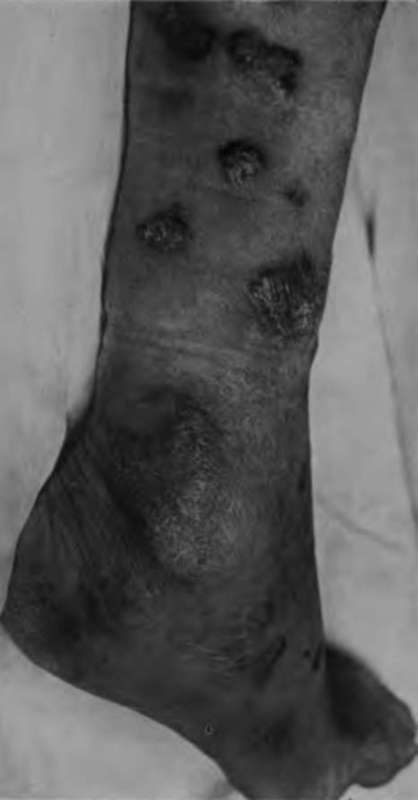Transitional Lesions
Description
This section is from the book "Skin Cancer", by Henry H. Hazen, A.B., M.D.. Also available from Amazon: Skin Cancer.
Transitional Lesions
Spiegler-Pendt Type
Tumors of the variety described by Spieg-ler,* Fendt,* Polland,* and others, and commonly called the Spiegler-Fendt type of sarcoid, seem to occupy an intermediate position between the Kaposi type of multiple sarcoma and the comparatively harmless sarcoids.
*Mariani: Arch. f. Dermat. u. Syphil., 1909, xcviii, 267.
*KObner: Berl. med. Wchnschr., 1883, No. 2.
*Sherwell: Amer. Jour. Med. Sc., Oct., 1892.
*Spiegler: Arch. f. Dermat. u. Syphil., 1894, xxvii, 163.
*Fendt: Arch. f. Dermat. u. Syphil., 1900, liii, 213.
*Polland: Arch. f. Dermat. u. Syphil., 1910, civ, 69; 1912, cxi, 69.
In this group of lesions are purplish-red tumors, usually lying deep in the cutis, essentially chronic in course, showing no ulceration, and almost invariably giving no metastases, although Spiegler has reported one fatal ease. Histologically, there are more or less circumscribed areas of small round-celled infiltration. These aggregations may be inclosed in a connective tissue capsule. At times a few giant or epithelial cells may occur. Fox and Wile* very pertinently remark: "It is highly probable that many, if not all, of the so-called cured cases of sarcomatous cutis belong to this group, which is really distinguished from true sarcomatosis cutis by the extreme malignancy of the latter and its tendency to invade the inner organs".

Fig. 57.-Multiple hemorrhagic sarcoma (Kaposi). (Heldingsteld's collection).
Continue to:
- prev: Multiple Lesions
- Table of Contents
- next: Sarcoids
Tags
bookdome.com, books, online, free, old, antique, new, read, browse, download
